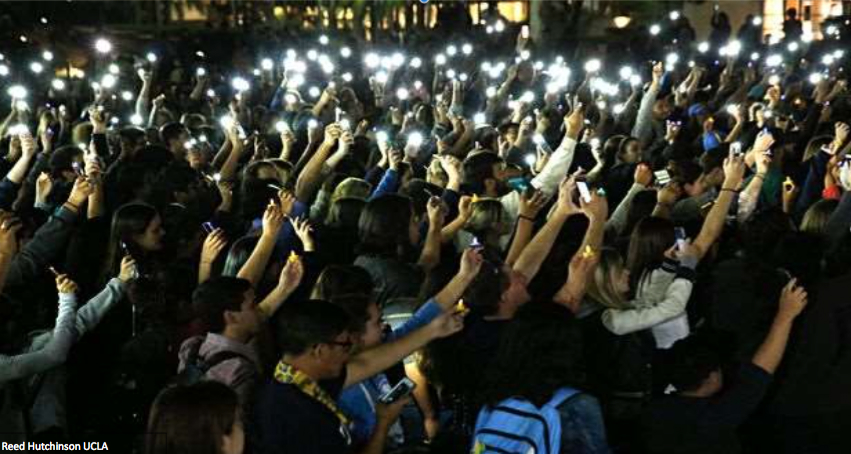By Elaine Howell, Communications Specialist, IT Services, Digital Content Services, UCLA. IT Services is making it easier for UCLA to communicate and stay safe during emergencies.
Last June, after a fatal shooting on campus, UCLA Chancellor Gene Block asked Executive Vice Chancellor and Provost Scott L. Waugh to organize a Task Force to examine campus safety measures and recommend ways of improving them. Task Force members included vice chancellors, deans, faculty, students, and executives from across the campus.
The Campus Safety Task Force requested input from the campus community in various ways. More than six hundred people answered an online survey, and 90 attended the Campus Community Forum. In addition, the Task Force examined the results of a survey conducted within a few weeks of the incident, which yielded 9,795 responses.
The high level of campus engagement, as well as briefings from key departments and external organizations, offered tremendous value to the Task Force as it assessed the many aspects of emergency preparation and response and how UCLA can improve upon them.
In October 2016, the Task Force made 21 recommendations, organized into four categories: preparedness training, communications, building security, and counseling and support. This article focuses on four technology-related recommendations that UCLA IT Services is helping to accomplish.
Maximize awareness and use of BruinAlert system
One recommendation is concerned with increasing the visibility of and the distribution list for UCLA’s emergency notification system, BruinAlert. The Task Force recommended that all UCLA faculty, students and staff sign up for BruinAlert text messages so these important emergency messages will reach more of our campus community.
To accommodate this recommendation, the UCLA Office of Emergency Management (OEM) migrated the BruinAlert system to a new vendor, Everbridge. IT Services worked with OEM to develop a data feed that transferred all employee and student information into the new system. IT Services also enabled UCLA single sign-on (authentication) for the BruinAlert online member portal, enabling a secure way for users to add and edit their emergency contact information.
In the coming months, users will also be able to add and update their BruinAlert contact information from a redesigned UCLA Logon page.
Create a website to communicate information during emergencies
A second recommendation is to create a means of conveying information online quickly and more thoroughly than in a tweet, text or status update. The Office of Emergency Management worked with the IT Services Web Content and Strategy team to get the new Bruins Safe Online website up and running. In the future, the Emergency Operations Center can keep this site updated with official information and instructions.
Integrate electronic locks with BruinCard
A third recommendation suggests expanding the installation of BruinCard-controlled electronic door locks to enable remote locking capabilities. IT Services partners with Corporate Financial Services to operate the BruinCard System. All BruinCard-controlled doors are connected to the BruinCard application. Campus door administrators and safety officers can remotely program each door’s locking schedule and access list. In an emergency, BruinCard-controlled doors can be remotely locked down with a simple command from the application.
An analysis found that retrofitting all doors, external and internal, across campus might be cost-prohibitive. However, Capital Programs is working with IT Services and Corporate Financial Services to investigate retrofitting exterior doors on existing buildings and incorporating electronic locks as a standard for new construction.
Expand wireless and cellular coverage
Finally, a fourth recommendation calls for better wireless connectivity and cell phone reception across campus, especially in building basements and other areas where reception is poor or non-existent.
To improve cellular reception, the IT Services Consulting and Contracts group is working with AT&T, T-Mobile, and Verizon on options such as using low-powered radio access nodes called small cells and expanding the existing distributed antenna system to provide better overall campus cellular coverage.
And to expand wireless connectivity, the IT Services Managed Network Services team installed 547 new access points during the last fiscal year (2016/17). The team will continue over the next few years to install approximately 1,200 more access points across campus as well as update older equipment.
The IT Services Infrastructure Engineering group just completed a campus-wide survey to identify problem areas and will be issuing a report soon with additional recommendations and cost estimates.
Next steps
As the Task Force emphasized, most of its recommendations will “require sustained efforts” among many participating campus departments. IT Services will continue its collaboration over the coming years to further these initiatives and help protect the UCLA community.
For more information, please read the Campus Safety Task Force’s full report, complete with recommendations, survey results and comments from students, faculty and staff.







